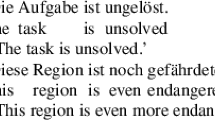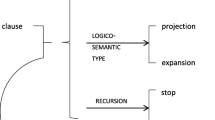Abstract
The overarching goal of this article is to account for why the Internally-Headed Relative Clause, the direct perception, and the factive constructions in Korean have an identical form involving the pronominal kes and the relativizer -un, despite the fact that one construction instantiates relativization and the other two instantiate complementation. I solve this puzzle by recasting Kim’s (2007) analysis of Internally-Headed relatives in a Kratzerian situation semantic framework (e.g., Kratzer 1989, 1998, 2002). The central claim is that the three kes-constructions have an identical form because they all instantiate situation subordination that is facilitated by an E-type pronoun and a relativization strategy. The proposed analysis shows that E-type pronouns and relativizers can have more flexible semantics than widely assumed. It also sheds new light on the connection between modification and complementation across languages. Furthermore, it provides an argument for Kratzerian situation semantic theory in dealing with the interpretations of complex clauses.
Similar content being viewed by others
References
Barwise, Jon. 1981. Scenes and other situations. Journal of Philosophy 78: 369–397.
Barwise, Jon, and John Perry. 1983. Situations and attitudes. Cambridge: MIT Press.
Basilico, David. 2003. The topic of small clauses. Linguistic Inquiry 34: 1–35.
Berg, Jonathan. 1988. The pragmatics of substitutivity. Linguistics and Philosophy 11(3): 355–370.
Carlson, Gregory, H. 1977. Reference to kinds in English. PhD Dissertation, University of Massachusetts-Amherst.
Chae, Hyon Sook. 2007. On the categorial ambiguity of the morpheme kes in Korean. Language Research 43(2): 229–264.
Chung, Chan, and Jong-Bok Kim. 2003. Differences between externally and internally headed relative clause constructions. In On-line proceedings of HPSG 2002, ed. Jong-Bok Kim, 3–25.
Chung, Dae-ho. 1999. A complement analysis of the head internal relative clauses. Language and Information 3: 1–12.
Déchaine, Rose-Marie. 1993. Predicates across categories. PhD Dissertation, University of Massachusetts-Amherst.
Dowty, David. 1979. Word meaning and montague grammar. PhD Dissertation, University of Texas.
Elbourne, Paul. 2005. Situations and individuals. Cambridge: MIT Press.
Felser, Claudia. 1999. Verbal complement clauses: a minimalist study of direct perception constructions. Philadelphia: John Benjamins.
Fuji, Masaaki. 1998. Temporal interpretation of internally headed relative clauses in Japanese. Working Papers from Rutgers University 1: 75–91.
Fukui, Naoki, and Margaret Speas. 1986. Specifiers and projection. MIT Working Papers in Linguistics 8: 128–172.
Guasti, Maria-Teresa. 1993. Causative and perception verbs: a comparative study. Torino: Rosenberg & Sellier.
Heim, Irene, and Angelika Kratzer. 1998. Semantics in Generative Grammar. Oxford: Blackwell.
Higginbotham, James. 1983. The logic of perceptual reports: an extensional alternative to situation semantics. The Journal of Philosophy 80: 100–127.
Horie, Kaoru. 1993. A cross-linguistic study of perception and cognition verb complements: a cognitive perspective. PhD dissertation, University of Southern California.
Hoshi, Koji. 1995. Structural and interpretive aspects of head-internal and head-external relative Clauses. PhD dissertation, University of Rochester.
Jhang, Sea-eun. 1991. Internally headed relative clauses in Korean. In Harvard studies in Korean linguistics, eds. Susumu Kuno , 269–280. Seoul: Hanshin Publishing.
Jhang, Sea-eun. 1994. Headed nominalizations in Korean: relative clauses, clefts, and comparatives. PhD dissertation, Simon Fraser University.
Jo, Mi-Jeung. 2003. The correlation between syntactic nominalization and the internally headed relative constructions in Korean. Studies in Generative Grammar 13: 535–564.
Jung, Yunsun. 1995. Internally headed relative clauses in Korean. In Harvard studies in Korean linguistics, eds. Susumu Kuno , 235–248. Seoul: Hanshin.
Karttunen, Lauri. 1973. Presuppositions of compound sentences. Linguistic Inquiry 4: 169–193.
Kim, Min-Joo. 2004. Event structure and the internally-headed relative clause construction in Korean and Japanese. PhD Dissertation, University of Massachusetts Amherst.
Kim, Min-Joo. 2007. Formal linking in internally headed relatives. Natural Language Semantics 15: 279–315.
Kim, Nam-Kil. 1984. The grammar of Korean complementation. Center for Korean Studies, Manoa: University of Hawaii at Manoa.
Kim, Yong-Beom. 2002. Relevancy in internally headed relative clauses in Korean. Lingua 112: 541–559.
Kiparsky, Paul, and Carol Kiparsky. 1970. Fact. In Progress in linguistics, eds. Manfred Bierwisch and Karl Erich Heidolph, 143–173. The Hague: Mouton.
Klein, Ewan, and Ivan Sag. 1985. Type-driven translation. Linguistics and Philosophy 8: 163–201.
Klein, Wolfgang. 1994. Time in languageLondon: Routledge.
Koopman, Hilda, and Dominique Sportiche. 1991. The position of subjects. Lingua 85: 211–258.
Kratzer, Angelika. 1989. An investigation of the lumps of thought. Linguistics and Philosophy 12: 607–653.
Kratzer, Angelika. 1998. Scope or pseudoscope? Are there wide-scope indefinites? In Events and grammar, ed. Susan Rothstein, 163–196. Dordrecht: Kluwer Academic.
Kratzer, Angelika. 2002. Facts: particulars or information units? Linguistics and Philosophy 25(2): 655–670.
Kratzer, Angelika. 2008. Situations in natural language semantics. Stanford Encyclopedia of Philosophy. http://plato.stanford.edu/entries/situations-smantics/#SitSemDavEveSem.
Kuno, Susumu. 1973. The structure of the Japanese language. Cambridge: Massachusetts Institute of Technology.
Kuroda, Shige-yuki. 1992. Japanese syntax and semantics. Dordrecht: Kluwer Academic.
Landman, Fred. 1992. The progressive. Natural Language Semantics 1: 1–32.
Landman, Fred. 2000. Events and plurality: the jerusalem lectures. Dordrecht: Kluwer Academic.
Lee, Jeong-Rae. 2006. The Korean internally headed relative clause construction: its morphological, syntactic and semantic aspects. Dissertation, University of Arizona
Lee, Miae. 2004. Focus-induced constraints in head-internal relatives. In Harvard studies in Korean linguistics, eds. Susumu Kuno , 568–581. Seoul: Hanshiu Publishing.
Lefebvre, Claire, and Pieter Muysken. 1988. Mixed categories, nominalizations in Quechua. Boston: Kluwer Academic.
Link, Godard. 1983. The logical analysis of plurals and mass terms: a lattice-theoretical approach. In Meaning, use and interpretation of language, eds. R. Bauerle, , 302–323. Berlin: Walter de Gruyter.
Matsuda, Yuki. 2002. Event sensitivity of head-internal relatives in Japanese. Japanese/Korean Linguistics 10: 629–643.
Ohara, H.K. 1993. On Japanese internally headed relative clauses. In Vol. 18 of Proceedings of BLS, eds. Buszard-Wechsler et al., 100–109.
Parsons, Terence. 1990. Events in the semantics of English: a study in subatomic semantics. Cambridge: MIT Press.
Partee, Barbara H., and Mats Rooth. 1983. Generalized conjunction and type ambiguity. In Meaning, use, and interpretation of language, eds. Rainer Bäuerle, Christoph Schwarze, Arnim, and von Stechow, 361–383. Berlin: de Gruyter.
Portner, Paul. 1992. Situation theory and the semantics of propositional expressions. PhD dissertation, University of Massachusetts at Amherst.
Sells, Peter. 1986. Coreference and bound anaphora: a restatement of the facts. In Vol. 16 of Proceedings of NELS, eds. Jae-Woong Choe, Stephen Berman, and Joyce McDonough. Cambridge: University of Massachusetts-Amherst: GLSA publications.
Shimoyama, Junko. 1999. Internally headed relative clauses in Japanese and E-type anaphora. Journal of East Asian Linguistics 8: 147–182.
Author information
Authors and Affiliations
Corresponding author
Rights and permissions
About this article
Cite this article
Kim, MJ. E-type anaphora and three types of kes-construction in Korean. Nat Lang Linguist Theory 27, 345–377 (2009). https://doi.org/10.1007/s11049-009-9065-5
Received:
Revised:
Accepted:
Published:
Issue Date:
DOI: https://doi.org/10.1007/s11049-009-9065-5




